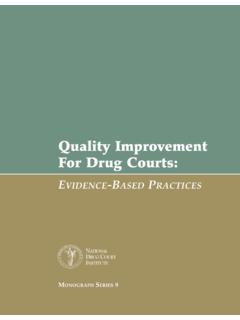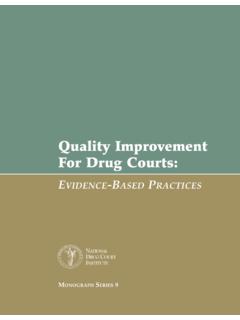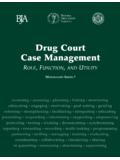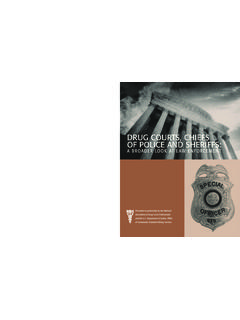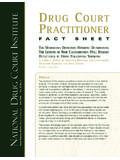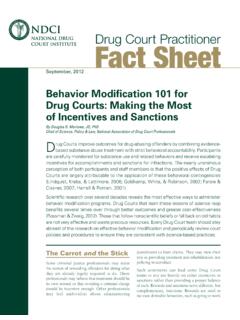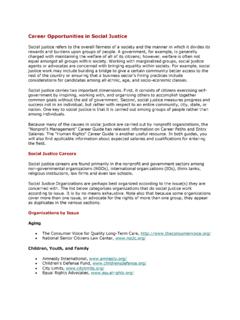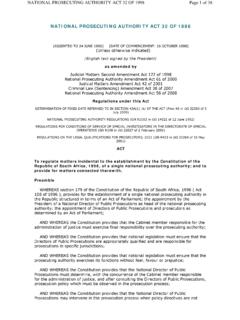Transcription of National Drug Court Institute Review, Volume I ... - …
1 National drug Court Institute review , Volume I, 1 1 RESEARCH ON drug COURTS: a critical review By Steven Belenko, The National Center on Addiction and Substance Abuse (CASA) At Columbia University June, 1998 This article appeared in Volume I, Issue 1 of the National drug Court Institute review National drug Court Institute review , Volume I, 1 2 Columbia University s National Center on Addiction and Substance Abuse (CASA) has provided the first major academic review and analysis of drug Court research to date. The author has reviewed 30 evaluations pertaining to 24 drug courts across the nation and concluded that a number of consistent findings emerge from available drug Court evaluations.
2 Importantly, the CASA study is the first to specifically look at the effectiveness of the drug Court model on offenders when they are participating in the drug Court program, comparing the drug Court model to other forms of community supervision. The study found that drug courts provide closer, more comprehensive supervision and much more frequent drug testing and monitoring during the program, than other forms of community supervision. More importantly, drug use and criminal behavior are substantially reduced while offenders are participating in drug Court . Dr. Belenko is one the nation s foremost researchers and writers on drug Court programs and the impact of drug abuse on the criminal justice system.
3 Dr. Belenko is a Senior Research Associate at the National Center on Addiction and Substance Abuse at Columbia University, where he authored a major study on drug abuse and prison populations Behind Bars: Substance Abuse and America s Prison Population: (1998). Founded in 1992, CASA is a nationally recognized policy research center that conducts major research, policy and program demonstration initiatives in the substance abuse field. EVALUATION (EV)- CONSISTENT FINDINGS [1] Despite the different drug Court statutes, jurisdictional differences, methods used by evaluators and the limitations of some data, a number of consistent findings emerge from available drug Court evaluations.
4 EV-RETENTION RATES [2] Retention rates for drug courts are much greater than the retention rates typically observed for criminal justice offenders specifically, and treatment clients in general. EV-POPULATION DEMOGRAPHICS [3] Although it is generally thought that drug courts target first-time offenders many drug Court participants have substantial criminal histories and many years of substance abuse. EV- SUPERVISION [4] drug courts provide closer, more comprehensive supervision and much more frequent drug testing and monitoring during the program than other forms of community supervision.
5 EV- COST-SAVINGS [5] drug courts generate savings, at least in the short term, from reduced jail/prison use, reduced criminality and lower criminal justice costs. EV- drug USAGE [6] drug use is substantially reduced while offenders are participating in drug Court . EV-RECIDIVISM DURING PROGRAM [7] Criminal behavior is substantially reduced while the offenders are participating in drug Court . EV- RECIDIVISM [8] Based on more limited data and to a lesser but still significant extent, drug courts reduce recidivism for participants after they leave the program. EV-DESIGN WEAKNESSES [9] The author analyzes existing evaluation designs, identifies weaknesses and makes recommendations for improvements.
6 National drug Court Institute review , Volume I, 1 3 National drug Court Institute review , Volume I, 1 4 INTRODUCTION AND BACKGROUND There has been great National interest in drug courts since the first one began operations in Dade County, Florida in The collaborations between the justice and treatment/public health systems epitomized by drug courts may offer considerable hope for a long-term reduction in drug -related crime and lower jail and prison populations. The general notion of dedicating specified courtrooms solely to drug cases is not new. Indeed, special drug case courtrooms operated both in Chicago and New York City in the early 1950s.
7 In the early 1970s, when heroin was the primary drug of abuse among offenders, New York City set up special "Narcotics Courts," in response to the passing of harsher drug laws. For the most part, however, these earlier efforts provided only limited access to drug treatment for offenders. Most drug courts did not emerge out of a vacuum; other methods and programs have been tried over the past 20 years to link offenders to drug treatment at various points of the criminal justice Some drug courts evolved from existing programs or efforts to engage defendants in treatment, such as Treatment Alternatives to Street Crime (TASC) program interventions, limited diversion programs, conditions of pretrial release, conditions of probation or in conjunction with intermediate sanctions.
8 But these earlier efforts were often fragmented, inconsistently or inappropriately used or not viewed as sufficiently effective. Supervision of treatment often rested on several agencies, and consequently, it was difficult to monitor treatment progress or compliance with Court -imposed conditions. As of April 1998, drug courts had been implemented in some 275 The drug Court model differs in important ways from previous efforts to provide drug treatment to offenders with underlying drug problems. In the drug Court model, the various components of the criminal justice and substance abuse treatment systems work together to try and use the coercive power of the Court to promote abstinence and prosocial By comparison, for the types of non-violent drug offenders generally targeted by drug courts, the typical adjudication process would result in a probation or short jail sentence, with little treatment or close community supervision.
9 The structure and procedures of drug courts also result in closer and more frequent supervision of offenders than typically seen under the standard probation or pretrial supervision that most nonviolent drug offenders experience, especially earlier in their criminal careers. The studies and data reviewed in this paper confirm that Court appearances, drug tests, supervision and treatment contacts are much more frequent under the drug Court model than under other forms of community supervision. The key goals of most drug courts are to reduce drug use and associated criminal behavior by engaging and retaining drug -involved offenders in programmatic and treatment services; to concentrate expertise about drug cases into a single courtroom; to address other defendant needs through clinical assessment and effective case management; and to free judicial, prosecutorial and public defense resources for adjudicating non- drug cases.
10 1 In this paper, the term drug Court refers to dedicated courtrooms that provide judicially-monitored treatment, drug testing and other services to drug -involved offenders. Specialized courts that provide expedited case management or accelerated case processing for drug cases, without integrated treatment, are not part of this review . National drug Court Institute review , Volume I, 1 5 The drug Court model usually entails: v judicial supervision of structured community-based treatment; v timely identification of defendants in need of treatment and referral to treatment as soon as possible after arrest; v regular status hearings before the judicial officer to monitor treatment progress and program compliance; v increasing defendant accountability through a series of graduated sanctions and rewards; v mandatory periodic drug testing.

